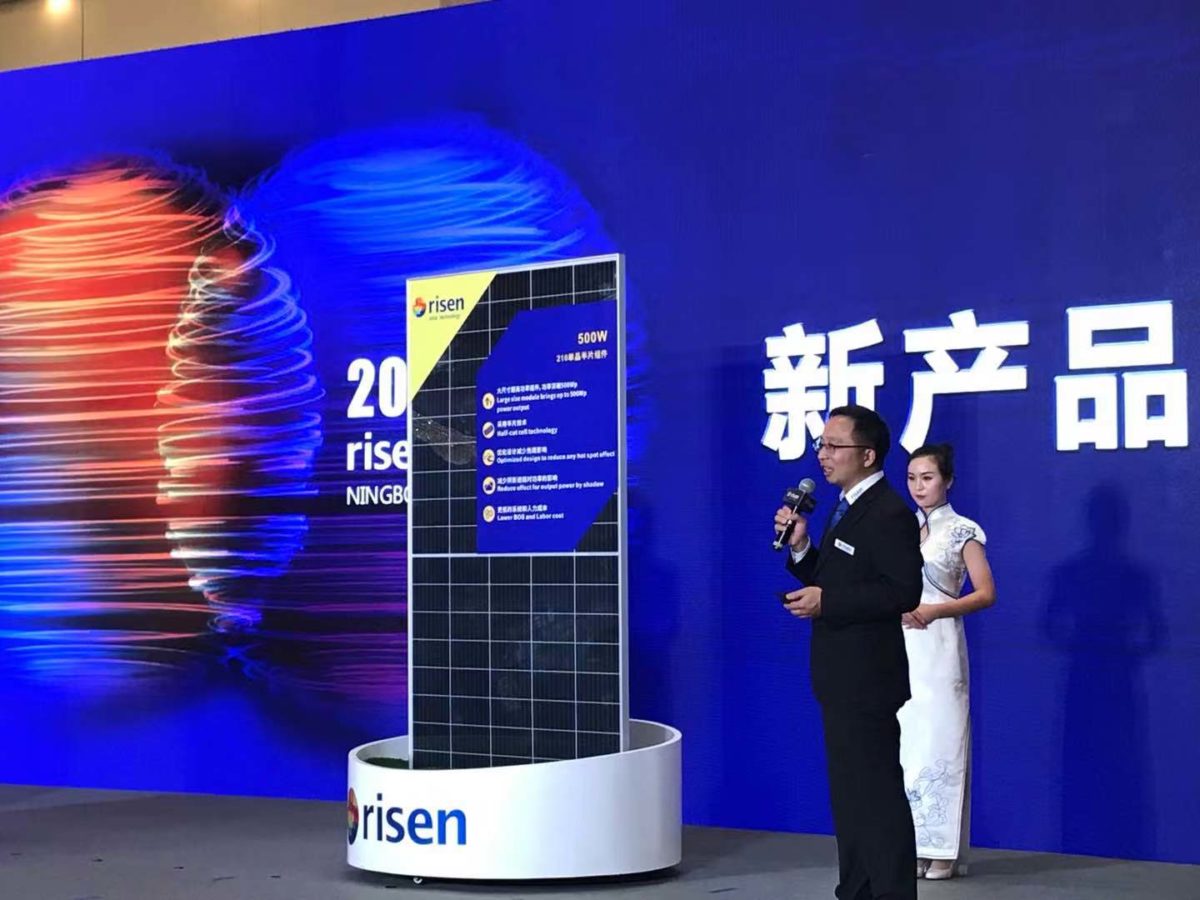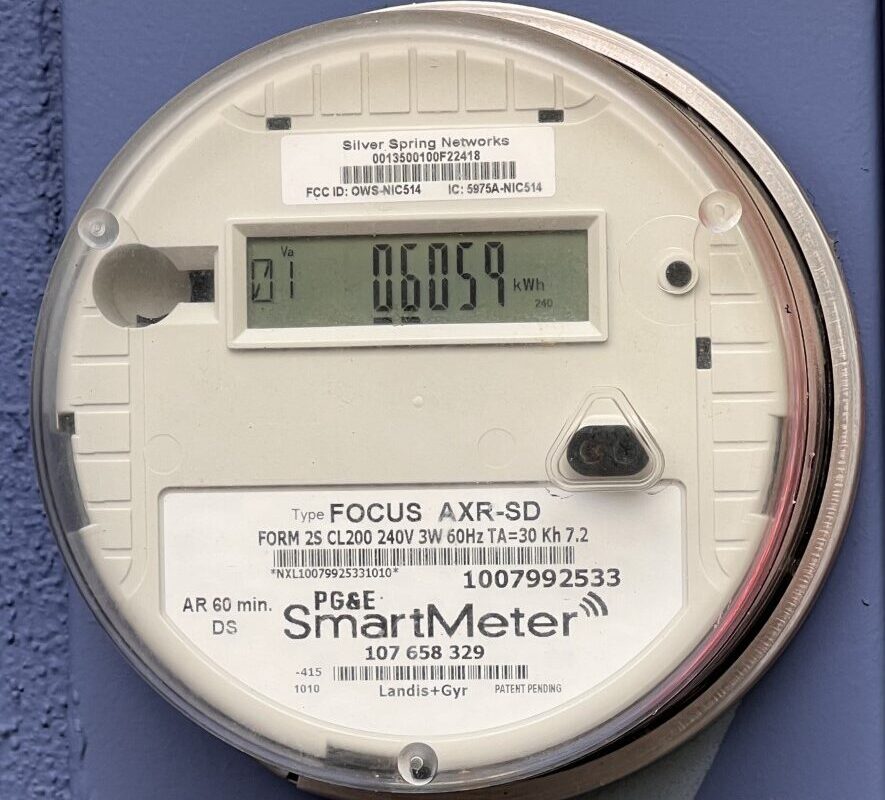There are two solar module manufacturers, Risen Energy and Trina Solar, that have unveiled first-of-their kind 500W, 50-cell, PV modules.
The Risen modules accomplish the feat using 50 half-cut monocrystalline PERC cells, witch each individual cell being 210 mm in size., The Trina panels use the came 210 mm silicon wafers, with the difference between the two companies being that Trina’s are tri-cut. What this results in is a 500W module that comes in just slightly larger than 72-cell designs with 156.75 mm wafers.
How will the advent of 500-watt solar modules change the solar industry?
“For applications where you have a lot of area, particularly commercial and especially utility-scale, it’s really significant,” CEO of Cinnamon Energy Systems Barry Cinnamon told pv magazine. “You could just use fewer modules, it reduces handling costs and overall balance-of-system costs go down.”
If there are less modules needed to reach the capacity specifications of a project, that means overall project costs will go down as these modules become economically viable. A significant area that will see cost reduction will come from the racking and trackers.
“It’s going to drive down the cost of racks and trackers per watt,” said Matt Kesler, head of technology at OMCO Solar, an Arizona-based racking and fixed tilt tracking manufacturer. “It’ll reduce the cost per watt of installation labor. It’s also going to give a premium on racks and trackers that are designed for ergonomics. As these things get bigger they’re going to get heavier and wider. if there are features in the trackers and racks that assist in the placement of the modules, that’s going to have more value.”
The consensus among the installers interviewed by pv magazine was that the average module installed checks in at 380W. This means that Trina and Risen’s panels deliver around 31% more power than the average installed panel. Cinnamon said that 10 years ago, the average module output was about 250W.
As neat as that calculation is, these panels have a long way to go until they are industry standards, let alone the benchmark for the average installation.
“It takes about five years for the industry to change all of its assembly equipment to a new size,” said Cinnamon “It’s a lot of work to buy new equipment because often it can’t be reprogrammed… We’re talking three to five years to change out all of that equipment.”
“The most common sector is going to be C&I,” said Jock Patterson of Fronius USA, an inverter company. “I see these on rooftops where space is limited and they want higher efficiency modules. Large suppliers are going to feel the pressure to supply an inverter that’s 1,500 volts. Those who aren’t providing that are going to feel like they’re missing out on those larger rooftop projects.”
That change will not be industry-wide. The residential solar market will see little direct impact as these modules become commercially available — as 72-cell modules have always been too large to be practical for home installations where roof space is limited, work spaces are angled and workers have to be able to carry the modules individually up ladders. Anything beyond the standard 1-meter by 1.6-meter 60-cell module is too cumbersome.
The hope for the residential installers that pv magazine spoke with was that the technologies used to get these modules to 500W will eventually tickle down to their 60-cell brethren. In turn, this would mean that residential installations would be able to take up less roof area while providing more power, ultimately driving down balance-of-system costs.
Risen claims that it could easily reach 600Wp of output with a 60-cell panel, but the size would make the panel too large to be handled by a single person.
Edit: This article was edited on 3/9/20 reflect that the modules are 50-cell, not 72-cell, as was initially reported. We apologize for the mistake.
This content is protected by copyright and may not be reused. If you want to cooperate with us and would like to reuse some of our content, please contact: editors@pv-magazine.com.









The PV module in the photo does not appear to have 72 cells, but rather 100 cells in a 5 x 20 layout. Also, there is a misleading comment about 1500V inverters and rooftops, when we all know that 1500V systems cannot be placed on rooftops, per the National Electrical Code. Further, it does not seem that efficiency improvements have led to this increase in power, but additional cells.
Ditto- this guy’s on it
Came here to say the same thing. This is a very misleading article. This is not a 72 cell mod, but what looks to be 100, half cell, large format cells (maybe 144 tallmax?), multi bussbar module. If these are like the rest of the tallmax line they might be bifacial to get to those big numbers . These are still only in the low 20’s for efficiency. This is great, but for all of these people commenting about fitting twice the solar in the same area, thats not what is happening here… although the article leads you to believe that. At the end of the day this is a module that squeezes most modern technologies and “tricks” into a single gigantic module. On a C&I project I believe it could save around ~3% due to fewer modules (fewer clamps, less wiring etc), but not because of some magic high efficiency. As you mentioned 1500V is not allowed on buildings in the US. All I know is at 80″x40″ @ 60lbs I am in no big hurry to lug these around or work the engineering.
Hi Mr.Sylvia
My name is Mihai Iancu ,I read you article and I will kindly ask for your advise regarding what kind of photovoltaic panel I should buy for one studio ,that should cover 2 AC ,1 Tv,1 fridge.Thank you and good luck!
More output on solar panels means less of a foot print. That is extremely valuable to some.
Not all systems will be roof mount. Houses in most cities just aren’t that large of a roof area.
The most relevant number for residential rooftop placement is the conversion efficiency, power per unit area.
Is 500w from 1 x 1.6 meters likely going to be possible? Woupdnt that be about 30% efficiency?
In the US commercial rooftops are limited to 1000V max by NEC 690.7 “PV system dc circuits on or in buildings shall be permitted to have a maximum voltage no greater than 1000 volts.”. Only ground mount may use 1500V.
Wondering what this will do the re-power market. Fields of solar panels that were put up 10 years ago could double or more their output – assuming the transmission capacity is there.
I haven’t watched residential solar installers, but I would have assumed that at least some of them would have gotten the ladder hoist systems by now. One of my neighbors had his roof replaced two years ago and the crew used one to get the shingles up.
I would love it if there was a 600W, 60-cell panel. Even 500W would be great.
It Is 24 or 48 Volt?
The 32 square foot commercial module would not be the optimum module for roof mount systems. The 18 square foot modules would be more appropriate or the mentioned 1 m by 1.6 m panel.
“Risen claims that it could easily reach 600Wp of output with a 60-cell panel.”
Bring it on, I’ve got about 1,800 square feet of roof space on the garage that a smaller footprint panel could fill. Having 50kWp is a substantial system to have available. Those “pipe dreams” of charging electric vehicles and having enough overgeneration for a large energy storage system to run off grid can become reality.
I’ve got 40 panels @250w on my roof now. If they came out with 600’s or even 500’s I’d seriously consider starting to swap them out as I had funds. I’d love to double my output.
These are larger panels intended for solar farms, so it would be like tearing off the 4 x 8 plywood roof sheathing to put larger 6 × 12 sheets on.
The power per unit area is maybe a little higher than your existing system, probably not worth upgrading it as the gains are small. Wait 25 years, or for a hailstorm.
800W is at 1000w/m2 test conditions at 77-degrees directly overhead At 120 w/m2 or less and 58-degree inclination and 32-degrees or less during northern State 8winters, a 18-panel solar roof can’t operate a microwave and toaster oven and a refrigerator and water heater, much less heat your house and recharge your EV.
That’s $40,000 for solar and battery wall you’ll never see again to sit in the dark and freeze around illegal wood stove all winter. More high-tech gritters.
What are the physical dimensions of these 500-w panels? If today’s 500-w panels are 3x the physical size of yesterday’s 250-w panels, then the efficiency loss in the newer panel is not helpful. Important to compare on a watt per sqft basis.
Given the wakeup from the Walmart fires, how much does 500W output and 1000 volt throughput increase the growing risk of fire due to overheat as well as risk of DC arcing and electrocution rises ?
Ken
our 500w solar PV product is a plug n play so no cable or inverter is inside the home as the 13amp plug is also outside.
send your email to us for further info
Wanting to set up school bus with cheap but big enough to fully power my home is there someone who can help me tell me what to get equipment wise and and and how to hook it all up
Nothing new here. It doesn’t matter how many cells because the new cells they are using are larger (200mm x 200mm roughly), so that’s comparing apples and oranges. Making a larger panel that produces more power does not qualify for new technology. I bet you the efficiency is still 20% at best.
Great to see viable options that are really coming on line for competition for electricity retailers, the next break through we need is cheap energy storage, Then there will be real competition for cheaper electricity.
3 of these on a southern section of my roof would be more than I or any homeowner in my hood per mo., would need. It’s about time for the door to door sales crew to arrive. not many ppl use mo than 1 KW/mo. I could run the a/c full blast all day and use utility elect at night, no storage batt’s. Make it so.
Very informative
Just I want to know what will be cost of solar panels site measurement is 30 x 40 feet on roof top for 3 or 6 kW on gride / off gride please quote Price supply , errection and service the unit
With regards
Joseph c Bangalore’ 560073 Karnataka India
Think it great news
I’ve developed a 1 Gwatt panel. Now we just need to get the one square mile size down a bit for transport purposes. Aircraft warning lights are recommended depending on mounting angle.
Would like to know if the Trina 500 watts available in New York City for home installation
Hello Jose. Modules of this magnitude are typically not recommended for residential installations. Their size can make them cumbersome and dangerous for crews to install on rooftops.
Yes Jose, available in NY
Hi, I’m looking for Pricing on two 500 Watt Solar Panels… I live in bc. Canada…😊🇨🇦
I’m very curious what the wind/snowload specifications on these larger modules are. That is a significant issue in Montana’s climate.
Chris
as our 500w solar product is a dish shape to go on your wall not the roof, you wont have any problem with snow. send us your email for further info
Well, in summer the sun is actually a bit north of us, so I’m not sure how useful a southerly “wall-mounted” solar module would be!